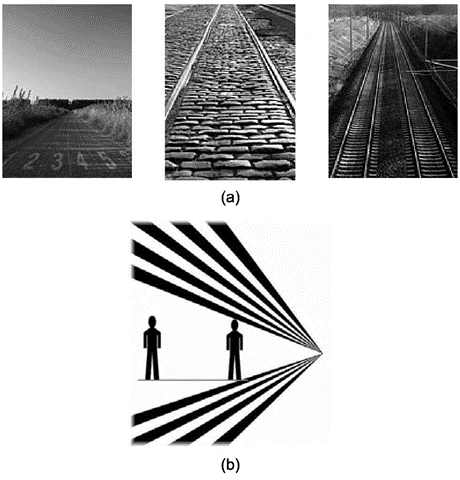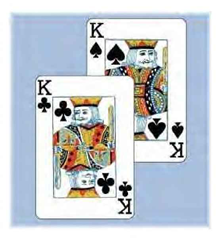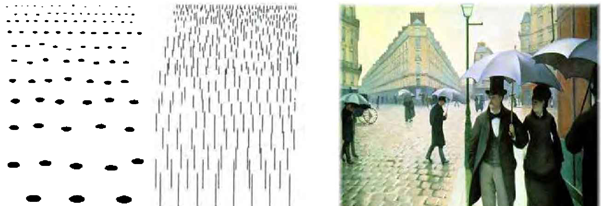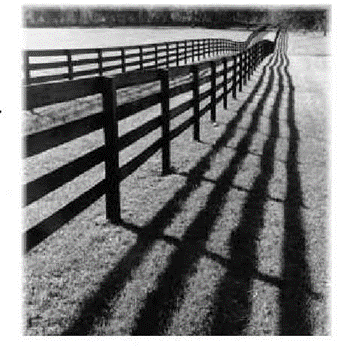Depth perception is a fundamental aspect of human visual cognition that enables organisms to interpret the three-dimensional structure of the environment from two-dimensional retinal images. This capacity to judge distances and spatial relationships among objects underlies virtually every visually guided action—ranging from basic locomotion and object manipulation to complex tasks such as driving, sports, and artistic composition.
The human visual system exploits a rich repertoire of cues—broadly categorized as binocular and monocular—to recover depth information. While binocular cues depend on the integrated input from both eyes, monocular cues can be obtained from a single eye and are often exploited in visual arts and imaging to convey depth. In this article, I expand on the principal binocular and monocular cues, describe their physiological and perceptual bases, discuss their interactions and limitations, and consider applied implications for safety, design, and visual media.
Binocular Cues
Binocular cues emerge from the fact that the eyes occupy distinct horizontal positions in the skull, resulting in slightly different viewpoints and therefore slightly different images of the same scene on each retina. The visual system exploits these interocular differences to infer depth in a process known as stereopsis. Two dominant binocular cues are retinal disparity and convergence.
Retinal Disparity
Retinal disparity, also termed binocular disparity, refers to the difference in the positions of corresponding features on the two retinas. Each eye receives a slightly shifted projection of the world because of its lateral separation; objects at different distances project to different relative positions across the two retinas. The visual cortex—especially areas V1 and higher-order cortices such as V2 and the dorsal and ventral streams—contains neurons tuned to particular disparity values. By comparing the relative positions of features across the two retinal images, the brain computes disparity and uses it as a direct metric for estimating relative depth. Small disparities indicate distant objects, whereas larger disparities generally indicate nearer objects (within the range of stereoscopic sensitivity).
Retinal disparity is especially powerful for depth discrimination over relatively short distances (typically within a few meters for human adults) and can convey very fine depth differences, enabling precise tasks such as threading a needle or judging the exact position of a cup. However, stereopsis is limited by factors such as poor binocular fusion (e.g., in amblyopia or strabismus), very large disparities that exceed fusion limits (diplopia), and low texture or featureless surfaces that lack corresponding points.
Convergence
Convergence is the angular rotation of the eyes toward the midline when fixating on a near object. To focus on a close target, the oculomotor system rotates the eyes inward; the degree of inward rotation (convergence angle) increases as the object approaches. This geometric change provides a proprioceptive cue: the brain can use the amount of convergence—sensed either via extraocular muscle proprioceptors or via efference copy of motor commands—as an indicator of distance.
Convergence is particularly effective for very close ranges (within approximately 1 meter), where the angular changes are appreciable and provide a reliable metric for absolute distance. Unlike disparity, which primarily signals relative depth among objects in the visual field, convergence offers a sense of absolute distance for near targets. Nevertheless, convergence signals can be ambiguous when accommodation (focusing) and vergence are decoupled, and their reliability decreases with increasing viewing distance because the changes in vergence angle become vanishingly small.
Interaction of Binocular Cues
Retinal disparity and convergence do not function in isolation. In natural viewing, they are integrated with accommodation (lens focusing), motion parallax, and monocular cues to create a robust depth percept. The visual system weighs these inputs according to context and reliability: for close-range tasks, convergence and disparity carry substantial weight; at longer ranges, monocular cues and pictorial information become more influential. Importantly, binocular cues can correct some ambiguities of monocular information, such as uncertainty about absolute distance that arises from size or perspective cues alone.
Monocular Cues
Monocular cues are depth signals available to one eye only, and they remain effective even when stereoscopic information is absent. These cues are central to pictorial depth in drawing, painting, photography, and cinematography, where two-dimensional media need to evoke a convincing sense of three-dimensional space. Key monocular cues include linear perspective, relative size, interposition (occlusion), texture gradient, and light-and-shadow shading, among others (such as aerial perspective, motion parallax, and atmospheric effects). I expand on each primary cue and discuss perceptual mechanisms, examples, and limitations.
Linear Perspective
Linear perspective arises from the projective geometry of the retinal image: sets of parallel lines in the three-dimensional world converge to a vanishing point in the two-dimensional projection as they recede into the distance. The extent to which these lines converge provides a powerful pictorial cue for depth: the more rapid the convergence, the greater the perceived distance. Artists have long exploited linear perspective to create convincing spatial depth on a flat canvas; Renaissance painters formalized techniques to construct accurate vanishing points and horizon lines to produce realistic scenes.

Psychophysically, linear perspective conveys relative depth relationships and structural layout of the scene—such as roads, railway tracks, building facades, and interior spaces. However, it can also mislead observers when other cues are absent, conflicting, or misinterpreted. For example, studies and accident analyses suggest that linear perspective can lead observers to overestimate the distance to an oncoming object along converging tracks or a roadway, contributing to errors in judgments of train distance or vehicle speed (Leibowitz, 1985). The perceived convergence interacts with assumptions about scene geometry (e.g., parallelism) and viewer viewpoint; when such assumptions are violated, depth inference can be erroneous.
Relative Size
Relative size is the cue by which objects that produce larger retinal images are perceived as closer than objects that produce smaller retinal images, provided the observer assumes the objects are of comparable physical size. This cue depends critically on prior knowledge or reasonable assumptions about object size: for instance, when two human figures are known to be roughly the same height, the smaller retinal image is interpreted as indicating greater distance.

Relative size functions both as an absolute and relative cue. When the viewer knows the standard size of a familiar object (familiar size), it can serve as an absolute metric for distance estimation. In absence of familiarity, relative size operates relationally—comparing sizes among elements in the scene to infer depth order. Artists use graduated scaling of objects—painting distant figures smaller and nearby figures larger—to create depth. In applied settings, such as driving, reliance on relative size can produce misjudgments: children or small pedestrians may be perceived as more distant than they are because they produce smaller retinal images, potentially leading to safety hazards (Stewart, 2000).
Interposition (Occlusion)
Interposition, or occlusion, is the straightforward cue that arises when one object partially blocks another. The occluding object is perceived as nearer than the occluded object. This cue is categorical and robust: the presence of occlusion provides unambiguous ordinal information about relative depth (i.e., object A is in front of object B), though it does not specify exact distances. Interposition also informs object segmentation and completion processes in vision: the brain infers the continuity of occluded surfaces and reconstructs hidden parts based on shape and context.

Occlusion interacts with other cues to yield a coherent scene interpretation. For instance, when occlusion conflicts with size or perspective cues (e.g., a small object that occludes a large object), the visual system must resolve the inconsistency, often favoring occlusion for ordering while using other cues to estimate quantitative distance.
Texture Gradient
Texture gradient refers to the progressive change in the apparent density, size, and clarity of repetitive texture elements as they recede in space. Near surfaces display coarse, well-defined textures with larger elements, while distant surfaces appear finer, denser, and less distinct. The visual system interprets this systematic change as a depth gradient: regions where texture elements compress and blur are perceived as farther away.

Texture gradient is especially effective in scenes with regular, repeated patterns—paved surfaces, fields, and tiled floors—where relative compression of elements is readily observable. Gibson (1950) emphasized the ecological validity of texture gradients as reliable information for perceiving layout and affordances in the environment. In practical applications such as computer graphics and photography, rendering graduated texture detail enhances depth realism. Limitations of texture gradient arise when surfaces lack texture or when lighting and atmospheric conditions alter apparent detail independently of distance.
Light and Shadow (Shading)
The interplay of light and shadow provides potent cues to surface shape and depth. Variations in luminance across a surface—illuminated regions, gradual shading, cast shadows—convey information about three-dimensional form, relative orientation, and spatial relations between objects. Shading cues allow the visual system to infer convexity versus concavity, surface slant, and the presence of occluding objects that cast shadows on one another.

Perceptual interpretation of shading depends on assumptions about light source directionality (commonly a bias toward an overhead light source), surface reflectance properties, and scene illumination. Misinterpretation can occur when these assumptions are violated—for example, ambiguous shading can lead observers to reverse perceived convexities or misattribute cast shadows to surface texture. In applied visual design, skillful manipulation of shading and shadows can dramatically enhance the appearance of depth in two-dimensional renderings.
Additional Monocular Cues
Beyond the primary cues discussed above, several other monocular sources contribute to depth perception:
- Aerial perspective (atmospheric attenuation): Distant objects appear hazier and desaturated due to scattering of light by the atmosphere, which can signal depth across very long distances.
- Motion parallax: During observer movement, nearer objects move faster across the retina than distant objects. Motion parallax provides dynamic monocular depth information and is particularly informative when binocular cues are poor or absent.
- Accommodation: Changes in lens curvature for focusing provide proprioceptive signals to the brain about object distance; however, accommodation is most useful at short ranges and is linked to convergence.
- Familiar size: Knowledge of the typical size of objects (e.g., cars, humans) allows absolute distance estimates from retinal image size.
- Relative height: Objects positioned higher in the visual field, relative to the horizon, are often perceived as farther away, provided the ground plane is continuous.
Each monocular cue supplies specific types of information—some ordinal (which object is nearer), some metric (approximate distance)—and their utility varies with viewing conditions and scene content.
Integration of Cues and Perceptual Inference
Depth perception is best characterized as a process of multisensory integration and probabilistic inference: the brain combines available depth cues, weighting them according to reliability, prior knowledge, and contextual constraints. Bayesian frameworks have been fruitful in modeling how cues are combined to minimize uncertainty in perceived depth. For example, when binocular disparity is clear and informative, it may dominate; when one eye is occluded or disparity information is degraded, the visual system relies more heavily on monocular and pictorial cues.
Conflicts among cues reveal much about perceptual processing. In many experiments, observers may favor one cue over another depending on the nature of the task (e.g., absolute distance estimation versus relative ordering), their prior experiences, and even cultural or training factors. Visual illusions—such as the Ames room, the Ponzo illusion, or forced-perspective photography—deliberately exploit cue conflicts to produce striking misperceptions of size and depth, underscoring the inferential nature of depth perception.
Physiologically, integration occurs across multiple brain regions: early visual areas encode local features such as disparity and orientation; dorsal stream regions (e.g., posterior parietal cortex) integrate spatial and motion cues for action guidance; ventral stream regions contribute to object recognition and the use of familiar-size information. Feedback connections and top-down processes (attention, expectations) further modulate depth interpretations.
Limitations, Individual Differences, and Development
Depth perception capabilities vary across individuals and change across the lifespan. Infants develop the use of binocular disparity over the first months of life, with stereopsis emerging as the visual system matures. Certain clinical conditions—strabismus (ocular misalignment), amblyopia (“lazy eye”), and monocular vision due to injury—can impair binocular depth cues and lead to compensatory reliance on monocular cues. Age-related changes in ocular optics, reduced contrast sensitivity, and slowed accommodation can alter the weighting and effectiveness of cues in older adults.
Environmental factors such as low light, fog, or featureless surfaces reduce the availability and reliability of depth cues, increasing the likelihood of misjudgment. Technological contexts—virtual reality, augmented reality, and 3D displays—pose challenges in providing consistent cues (for example, the vergence-accommodation conflict in stereoscopic displays) and can induce discomfort or misperception if cues are incongruent.
Applied Implications
A comprehensive understanding of binocular and monocular cues has practical implications across domains:
- Transportation safety: Knowledge of how perspective and relative size can mislead distance estimates informs road and railway design, signage, and public education to reduce accidents (e.g., training drivers to account for pictorial illusions that over- or underestimate the speed and distance of trains).
- Visual design and art: Artists and designers exploit linear perspective, shading, texture gradients, and scale to create compelling illusion of depth in two-dimensional media, and to guide viewer attention and interpretation.
- Human–computer interaction and virtual environments: Effective rendering of depth cues (correct disparity, coherent motion parallax, realistic shading) enhances immersion and reduces simulator sickness.
- Clinical vision care: Rehabilitation for patients with impaired binocular function emphasizes training in monocular cue utilization and adaptive strategies to recover functional depth-based behaviors.
Conclusion
Depth perception is an intricate and vital component of visual cognition that arises from the interplay of binocular cues—such as retinal disparity and convergence—and a diverse repertoire of monocular cues including linear perspective, relative size, interposition, texture gradient, and light-and-shadow shading. Each cue conveys different types of information, and the perceptual system integrates them adaptively to produce robust estimates of distance and spatial configuration.
Understanding the mechanisms, limitations, and interactions of these cues not only enriches fundamental knowledge of human perception but also informs practical applications in safety, design, clinical practice, and digital media. The richness and flexibility of depth perception underscore the brain’s remarkable capacity to reconstruct three-dimensional reality from inherently ambiguous two-dimensional retinal projections.
Discover more from Decroly Education Centre
Subscribe to get the latest posts sent to your email.
